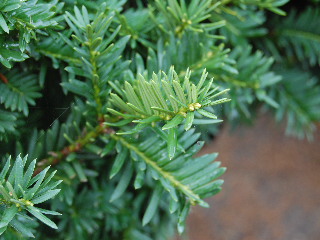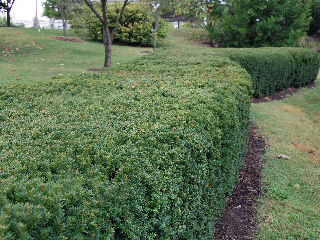
Taxus Media (Densiformis yew) is a moderately slow-growing, dense-foliage plant that attains a height up to 4 feet and can reach a spread of 6 feet.
Most often called “dense yews,” these evergreens are easy to plant, grow, and shape into a vital part of your home landscape.
The needles are not prickly to the touch, but of a rather soft texture, which makes handling the plants less of a chore and cleaning up the pruned branches less of a troublesome task.
The coloring of the dense yews is a soft green in the spring as new growth begins, then changing to a darker deeper olive green, which is maintained throughout most of the active growing season. As the colder weather of winter arrives, the needles sometimes turn to a reddish burgundy, and even to shades of brown if the season is severe.
The dense yews make great foundation plantings for your home. They can be planted and maintained as individual shrubs about 5 or 6 feet apart, or plant them a little closer together in a straight or curving line to form a nice hedge for a border. If you choose to shape your yews into a hedge, shear the tops straight across all at the same level and shear the front and back surfaces to whatever thickness you desire, but allow the sides to grow together to connect your yews into a graceful linear flowing hedge.
It's a good idea to shape your yews to be slightly more narrow at the top and tapering outward somewhat toward the bottom if you are growing a hedge. This allows sunlight to reach all growing parts of the evergreen foliage.
And, speaking of sunlight, the dense yews are not demanding at all in terms of light requirements. They will grow well in full sun and in almost total shade. However, the optimum light seems to be partial or filtered sun. Constant full sun can sometimes even burn the foliage in the heat of summer, causing it to turn to an unattractive brownish color.

The yews are not overly demanding of soil types, either, in order to grow well. A somewhat sandy soil seems to be their preference in order to thrive, although they will exist nicely in most any garden loam that is not too heavy with clay; and be sure the roots do not stay too wet as this can stunt or even kill the plants.
Once established, the densiformis yews are among the easiest of all landscaping plants to maintain. Pruning is the chief consideration so your plants won’t become too wild and wooly.
Feeding once a year, usually in the late winter or early spring before seasonal growth begins, helps maintain nicely colored, healthy-looking plants throughout the year. Use a balanced fertilizer or one with a slightly higher phosphorous content (the middle number of the 3-number fertilizer strength system, N-P-K) to assure good root development as well as lush top growth.
The dense yews are little affected by insects or disease. They are a hardy plant that even works well for landscaping in temperate coastal areas, being quite tolerant of the salt-air seashore conditions.
 Taxus Media (Densiformis yew) is a moderately slow-growing, dense-foliage plant that attains a height up to 4 feet and can reach a spread of 6 feet.
Taxus Media (Densiformis yew) is a moderately slow-growing, dense-foliage plant that attains a height up to 4 feet and can reach a spread of 6 feet.
 The yews are not overly demanding of soil types, either, in order to grow well. A somewhat sandy soil seems to be their preference in order to thrive, although they will exist nicely in most any garden loam that is not too heavy with clay; and be sure the roots do not stay too wet as this can stunt or even kill the plants.
The yews are not overly demanding of soil types, either, in order to grow well. A somewhat sandy soil seems to be their preference in order to thrive, although they will exist nicely in most any garden loam that is not too heavy with clay; and be sure the roots do not stay too wet as this can stunt or even kill the plants.